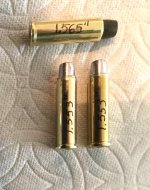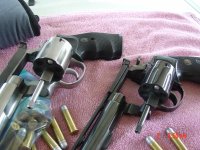38SPL HV
Member
Pictures below show three Keith type bullets seated (unloaded dummy rounds):
Top: Lyman 358429 170 gr coated (T&B Bullets) 1.565” OAL
Left bottom: Rim Rock 170 gr Keith 1.553” OAL
Right bottom: Matt’s Bullets (NOE moulds) 178 gr 1.553” OAL
Comments:
1. Lyman 358429 OAL per Lyman 1973 cast bullet manual
2. Both Rim Rock and Matt Bullets cannot be crimped over first driver band edge without reducing OAL below current Lyman recommended 1.553” OAL - crimping both the Rim Rick and Matt Bullets Keith’s over the first driver band edge will decrease OAL to 1.520”
3. 1/2 turn of Lee FCD is used and does not decrease OAL
Top: Lyman 358429 170 gr coated (T&B Bullets) 1.565” OAL
Left bottom: Rim Rock 170 gr Keith 1.553” OAL
Right bottom: Matt’s Bullets (NOE moulds) 178 gr 1.553” OAL
Comments:
1. Lyman 358429 OAL per Lyman 1973 cast bullet manual
2. Both Rim Rock and Matt Bullets cannot be crimped over first driver band edge without reducing OAL below current Lyman recommended 1.553” OAL - crimping both the Rim Rick and Matt Bullets Keith’s over the first driver band edge will decrease OAL to 1.520”
3. 1/2 turn of Lee FCD is used and does not decrease OAL


